Bomb craters (11) - Battle
Posted: 24 July 2014 21:17
In 1943, three German bombs fell on the town of Battle in a daylight tip and run raid. The sudden attack saw two civilians killed and much damage to property across the County. Archive documents and fieldwork reveal surviving evidence of the attack.
The three FW190s crossed the Sussex coast at Pett, strafing numerous farm buildings and cottages on their way to Battle, at 8.50am on Tuesday 2nd February.
The graphic below shows the 30-mile trail of destruction that resulted in 18 buildings being machine-gunned, in addition to the bombing at Battle. It gives a good indication of the menace of the tip-and-run raider; the whole series of attacks took place over just five minutes based on the times given in various reports - it might have been even less than this.

Surprise attack across East Sussex
The attack came without warning; ARP records indicate that the Air Raid warning was not sounded in the Battle area until 08:54 - after the bombs had dropped. The attackers were spotted by the Royal Observer Corps Post at Polegate at 08:52.
The reports from all along the flight path emphasise the low altitude of the raiders. One assumes that they crept in under the radar screen, hence no advanced warning.
The only 'success' against the raiders was 12 rounds of .303 fired by a Bren gunner of the Royal Welch Fusiliers as the FW190s made their first attack of the morning at Pett. Hits were claimed, but all three aircraft continued unabated. Not surprisingly, given the lack of warning and defensive reaction, the files of Anti-Aircraft Command down to the local AA Brigade have no reports of the raid.
It wasn't until I had chased the paper trail down to the war diary of a Light AA Regiment that I had some more evidence of defensive fire. As most AA guns were situated at Vulnerable Points (VPs) such as radar stations, airfields and coastal towns susceptible to the hit-and-run menace, the most likely places for AA guns to intercept were going to be on or near the coast. This perhaps dictated the raiders' path inland; the main threat to their safety was going to be crossing the coast on the way in and on the way out.
This means Cuckmere Haven, over which the raiders escaped, was going to be their most likely encounter with active defence after their lukewarm welcome at Pett. Friston Aerodrome, situated on the cliffs above the Cuckmere Valley, was a designated VP with 40mm Bofors guns protecting it. Unfortunately, the guns were sited to protect against raiders coming in off the sea at a minimum of cliff-top height:
08:55 - 3 FWs 190 flying south crossed coast at mouth of Cuckmere Haven, guns sited on cliffs...were unable to depress sufficiently to engage.
It seems that the gunners at Cuckmere Haven were alert and able to react, but the height above sea level of their guns, combined with the extreme low level flying of the raiders meant that the Focke-Wulfs escaped unchallenged as portrayed in the image below.
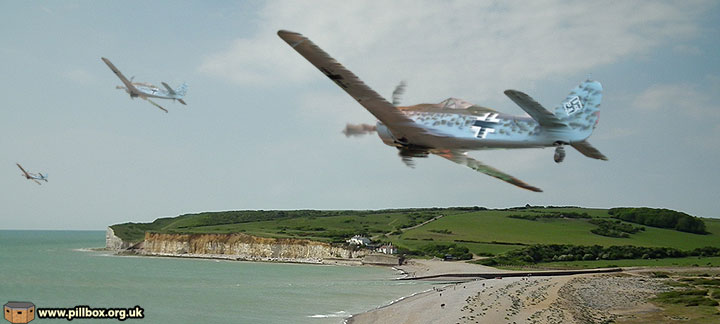
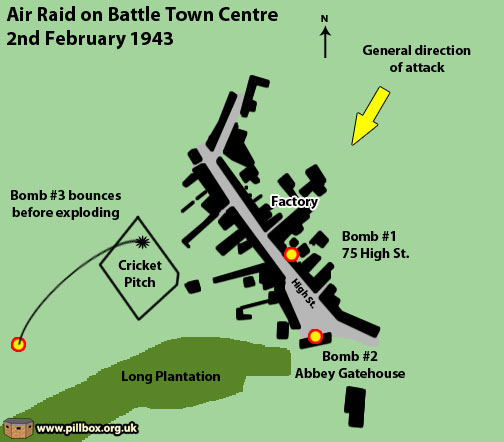
The attack on Battle
Three 500kg bombs were dropped on Battle and I've found evidence (of varying age) of all of them.
The map at right shows the impact of the bombs.
The numbers 1-3 used throughout are those assigned by the ARP documents; it's not known if this is order in which they were dropped. We'll examine bombs 1 and 3 in this part.
A brief account of the raid is given in The War in East Sussex, published by the Sussex Express and County Herald in August 1945.
While not all of the account matches what the official documents say, it states that the Germans were trying to bomb a jam factory in Battle High Street as a target of opportunity. The ARP reports mention the presence of the Canadians in the abbey, but rules them out as a specific target and points out that the farms and other buildings strafed throughout were on high ground and therefore prominent targets in the line of flight.
The photo below shows part of the High Street today. Although the jam factory closed some years ago, a "Newbery Preserves" sign can still be seen arching over the yard entrance at left. The blue arrow indicates No.75 High Street a few doors down, where bomb 1 actually hit; we'll investigate this bomb in due course.
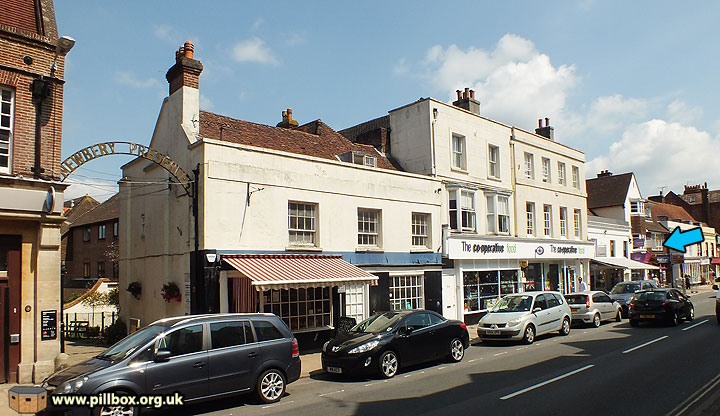
Bomb #3
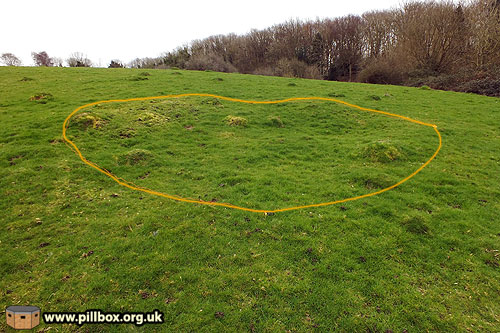
We'll start with Bomb 3; on initial impact it ploughed a 7m furrow in a cricket pitch (losing its tail unit) and then bounced 200m before exploding in a meadow.
The photo at right shows the crater, which has been backfilled. It was recorded by the ARP as being 20ft wide and 4ft 6 deep. Measuring up seventy years later, I found the crater was still identifiable as being 20ft across.
The explosion of this bomb broke windows in a house 300 yards away and a big window 500 yards distant. Vehicles of the Canadian Engineers who were stationed at Battle Abbey parked about 200m away were not affected.
It was not unusual for bombs to ricochet like this; dropped at low altitude (about 200 ft in this case) with forward momentum, bombs could fail to penetrate the ground and behave like stones being skimmed on a pond.
Between June 1942 and April 1943, over 100 incidents of ricochetting bombs were recorded in Southern England, 28 of which were in East Sussex. A report of these incidents includes this particular bomb, but not bomb #2, which hit the gatehouse of Battle Abbey.
Bomb #1 - Battle High Street
This was the bomb that just missed the jam factory; the photo below shows the High Street from the Abbey gatehouse, right above the spot that bomb #2 hit.
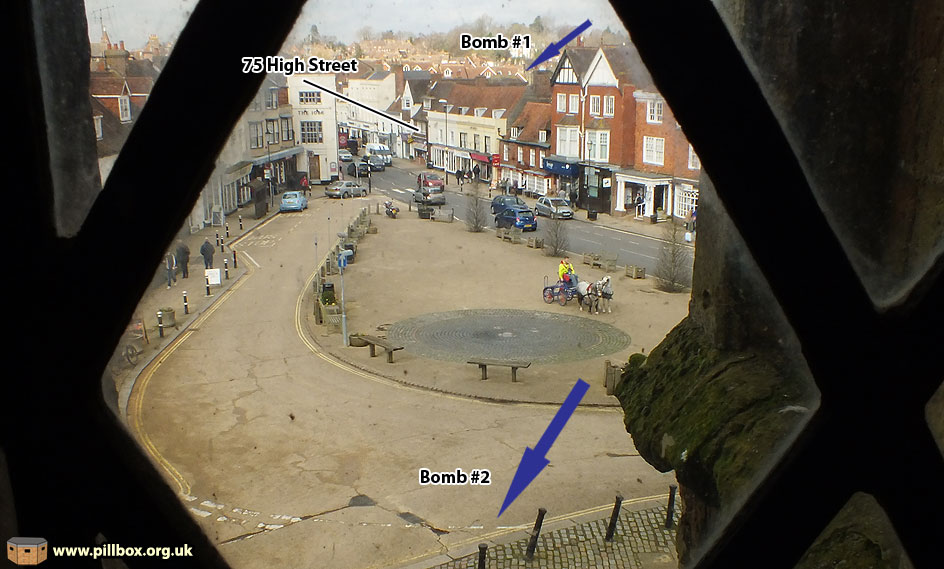
Bomb #1 fell just behind No.75 High Street, which was one of a terrace of four shops with living accommodation above. No.75 and two store buildings were completely destroyed, with five other properties within 15m of the impact receiving serious damage. Three more buildings were less seriously affected and a further 60 had light damage.
Given the number of buildings affected, it is not surprising that casualties were suffered; about 20 people were injured, but, tragically, Tom and Gladys Giles were killed in No.75. I located their grave in Battle Cemetery below.
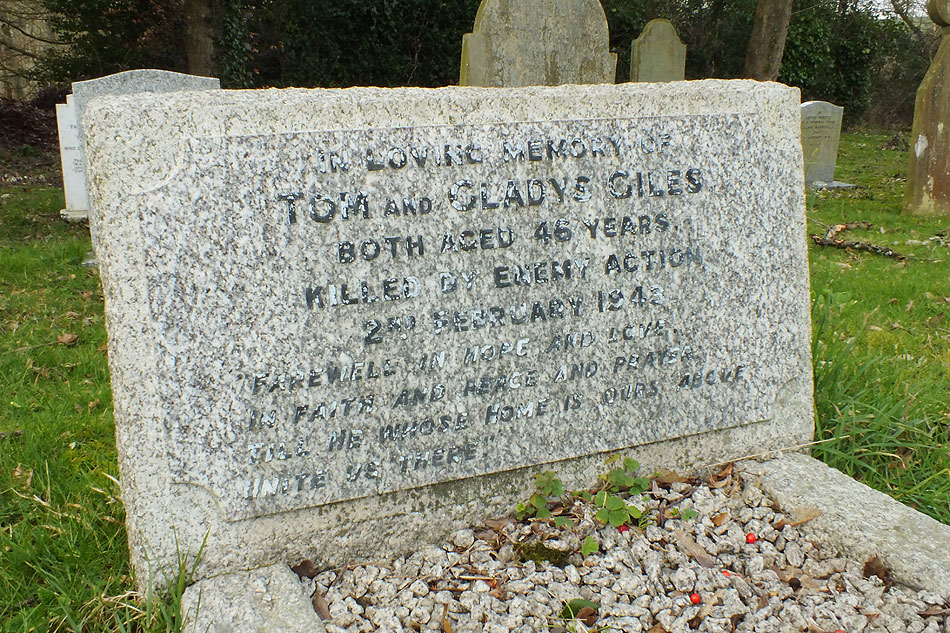
No.75 has since been rebuilt and is a newsagents today. A really nice touch is a brass plaque (below) on the shop front remembering the events of 1943.
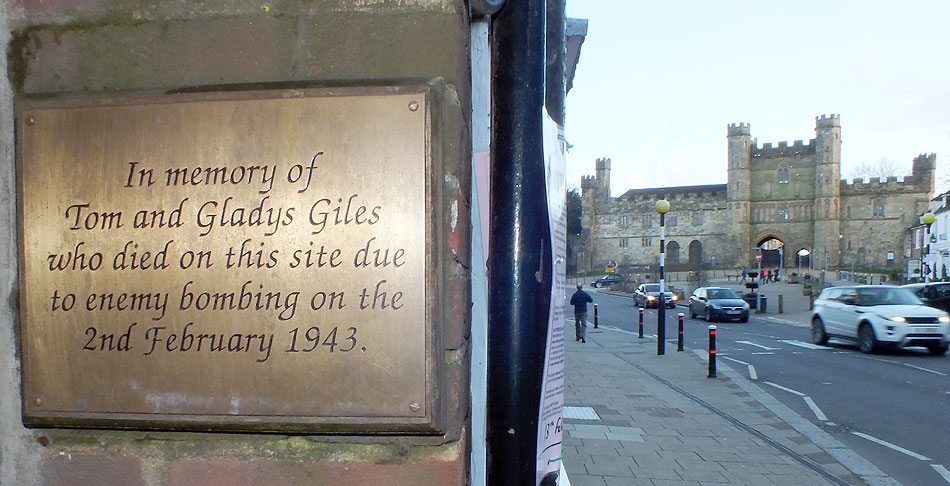
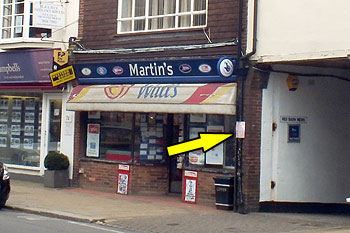
The photo at right shows No.75 today; the location of the plaque is indicated.
Hundreds of people probably walk past this small memorial every day without seeing it, but it's good that the events of that day are still remembered in Battle.
If you didn't know it was there, then please do stop and look for the plaque next time you're passing.
In part 2 of this piece, we'll examine bomb 2 that hit the Battle Abbey gatehouse.
- Pete

Email:
Blog Latest

Bishopstone reveals its pillbox secrets
18 October 2021

Pillbox or Observation Post?
10 June 2020

Uncovering the hidden secrets of a pillbox
8 June 2019

Review of 2018
31 December 2018

Wartime Christmas in East Sussex (2)
24 December 2018
Jargon-buster
War diary
A record of events kept by all units from the point of mobilisation. A diary's contents vary enormously from unit to unit; some give detailed entries by the hour on a daily basis while others merely summarise events on a weekly/monthly basis.
This site is copyright © Peter Hibbs 2006 - 2024. All rights reserved.
Hibbs, Peter Bomb craters (11) - Battle (2024) Available at: http://pillbox.org.uk/blog/216740/ Accessed: 27 July 2024
The information on this website is intended solely to describe the ongoing research activity of The Defence of East Sussex Project; it is not comprehensive or properly presented. It is therefore NOT suitable as a basis for producing derivative works or surveys!